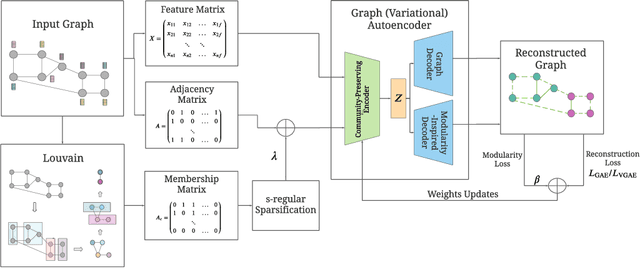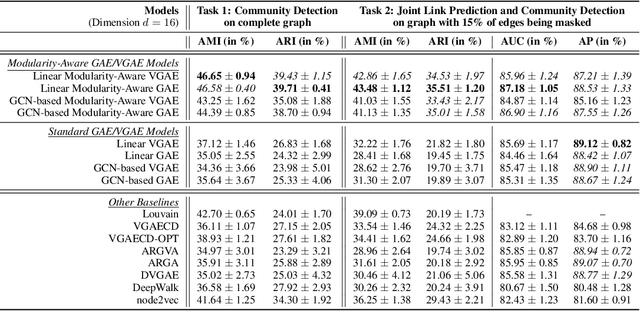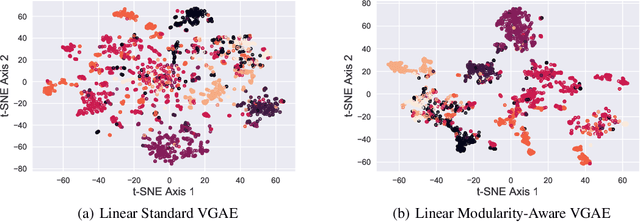Johannes F. Lutzeyer
Graph Representational Learning: When Does More Expressivity Hurt Generalization?
May 16, 2025Abstract:Graph Neural Networks (GNNs) are powerful tools for learning on structured data, yet the relationship between their expressivity and predictive performance remains unclear. We introduce a family of premetrics that capture different degrees of structural similarity between graphs and relate these similarities to generalization, and consequently, the performance of expressive GNNs. By considering a setting where graph labels are correlated with structural features, we derive generalization bounds that depend on the distance between training and test graphs, model complexity, and training set size. These bounds reveal that more expressive GNNs may generalize worse unless their increased complexity is balanced by a sufficiently large training set or reduced distance between training and test graphs. Our findings relate expressivity and generalization, offering theoretical insights supported by empirical results.
Gaussian Mixture Models Based Augmentation Enhances GNN Generalization
Nov 13, 2024



Abstract:Graph Neural Networks (GNNs) have shown great promise in tasks like node and graph classification, but they often struggle to generalize, particularly to unseen or out-of-distribution (OOD) data. These challenges are exacerbated when training data is limited in size or diversity. To address these issues, we introduce a theoretical framework using Rademacher complexity to compute a regret bound on the generalization error and then characterize the effect of data augmentation. This framework informs the design of GMM-GDA, an efficient graph data augmentation (GDA) algorithm leveraging the capability of Gaussian Mixture Models (GMMs) to approximate any distribution. Our approach not only outperforms existing augmentation techniques in terms of generalization but also offers improved time complexity, making it highly suitable for real-world applications.
Post-Hoc Robustness Enhancement in Graph Neural Networks with Conditional Random Fields
Nov 08, 2024Abstract:Graph Neural Networks (GNNs), which are nowadays the benchmark approach in graph representation learning, have been shown to be vulnerable to adversarial attacks, raising concerns about their real-world applicability. While existing defense techniques primarily concentrate on the training phase of GNNs, involving adjustments to message passing architectures or pre-processing methods, there is a noticeable gap in methods focusing on increasing robustness during inference. In this context, this study introduces RobustCRF, a post-hoc approach aiming to enhance the robustness of GNNs at the inference stage. Our proposed method, founded on statistical relational learning using a Conditional Random Field, is model-agnostic and does not require prior knowledge about the underlying model architecture. We validate the efficacy of this approach across various models, leveraging benchmark node classification datasets.
Centrality Graph Shift Operators for Graph Neural Networks
Nov 07, 2024



Abstract:Graph Shift Operators (GSOs), such as the adjacency and graph Laplacian matrices, play a fundamental role in graph theory and graph representation learning. Traditional GSOs are typically constructed by normalizing the adjacency matrix by the degree matrix, a local centrality metric. In this work, we instead propose and study Centrality GSOs (CGSOs), which normalize adjacency matrices by global centrality metrics such as the PageRank, $k$-core or count of fixed length walks. We study spectral properties of the CGSOs, allowing us to get an understanding of their action on graph signals. We confirm this understanding by defining and running the spectral clustering algorithm based on different CGSOs on several synthetic and real-world datasets. We furthermore outline how our CGSO can act as the message passing operator in any Graph Neural Network and in particular demonstrate strong performance of a variant of the Graph Convolutional Network and Graph Attention Network using our CGSOs on several real-world benchmark datasets.
Graph Neural Networks on Discriminative Graphs of Words
Oct 27, 2024



Abstract:In light of the recent success of Graph Neural Networks (GNNs) and their ability to perform inference on complex data structures, many studies apply GNNs to the task of text classification. In most previous methods, a heterogeneous graph, containing both word and document nodes, is constructed using the entire corpus and a GNN is used to classify document nodes. In this work, we explore a new Discriminative Graph of Words Graph Neural Network (DGoW-GNN) approach encapsulating both a novel discriminative graph construction and model to classify text. In our graph construction, containing only word nodes and no document nodes, we split the training corpus into disconnected subgraphs according to their labels and weight edges by the pointwise mutual information of the represented words. Our graph construction, for which we provide theoretical motivation, allows us to reformulate the task of text classification as the task of walk classification. We also propose a new model for the graph-based classification of text, which combines a GNN and a sequence model. We evaluate our approach on seven benchmark datasets and find that it is outperformed by several state-of-the-art baseline models. We analyse reasons for this performance difference and hypothesise under which conditions it is likely to change.
Hyper-Heuristics Can Profit From Global Variation Operators
Jul 19, 2024Abstract:In recent work, Lissovoi, Oliveto, and Warwicker (Artificial Intelligence (2023)) proved that the Move Acceptance Hyper-Heuristic (MAHH) leaves the local optimum of the multimodal CLIFF benchmark with remarkable efficiency. The $O(n^3)$ runtime of the MAHH, for almost all cliff widths $d\ge 2,$ is significantly better than the $\Theta(n^d)$ runtime of simple elitist evolutionary algorithms (EAs) on CLIFF. In this work, we first show that this advantage is specific to the CLIFF problem and does not extend to the JUMP benchmark, the most prominent multi-modal benchmark in the theory of randomized search heuristics. We prove that for any choice of the MAHH selection parameter $p$, the expected runtime of the MAHH on a JUMP function with gap size $m = O(n^{1/2})$ is at least $\Omega(n^{2m-1} / (2m-1)!)$. This is significantly slower than the $O(n^m)$ runtime of simple elitist EAs. Encouragingly, we also show that replacing the local one-bit mutation operator in the MAHH with the global bit-wise mutation operator, commonly used in EAs, yields a runtime of $\min\{1, O(\frac{e\ln(n)}{m})^m\} \, O(n^m)$ on JUMP functions. This is at least as good as the runtime of simple elitist EAs. For larger values of $m$, this result proves an asymptotic performance gain over simple EAs. As our proofs reveal, the MAHH profits from its ability to walk through the valley of lower objective values in moderate-size steps, always accepting inferior solutions. This is the first time that such an optimization behavior is proven via mathematical means. Generally, our result shows that combining two ways of coping with local optima, global mutation and accepting inferior solutions, can lead to considerable performance gains.
Understanding Virtual Nodes: Oversmoothing, Oversquashing, and Node Heterogeneity
May 22, 2024



Abstract:Message passing neural networks (MPNNs) have been shown to have limitations in terms of expressivity and modeling long-range interactions. Augmenting MPNNs with a virtual node (VN) removes the locality constraint of the layer aggregation and has been found to improve performance on a range of benchmarks. We provide a comprehensive theoretical analysis of the role of VNs and benefits thereof, through the lenses of oversmoothing, oversquashing, and sensitivity analysis. First, in contrast to prior belief, we find that VNs typically avoid replicating anti-smoothing approaches to maintain expressive power. Second, we characterize, precisely, how the improvement afforded by VNs on the mixing abilities of the network and hence in mitigating oversquashing, depends on the underlying topology. Finally, we highlight that, unlike Graph-Transformers (GT), classical instantiations of the VN are often constrained to assign uniform importance to different nodes. Consequently, we propose a variant of VN with the same computational complexity, which can have different sensitivity to nodes based on the graph structure. We show that this is an extremely effective and computationally efficient baseline on graph-level tasks.
Bounding the Expected Robustness of Graph Neural Networks Subject to Node Feature Attacks
Apr 27, 2024



Abstract:Graph Neural Networks (GNNs) have demonstrated state-of-the-art performance in various graph representation learning tasks. Recently, studies revealed their vulnerability to adversarial attacks. In this work, we theoretically define the concept of expected robustness in the context of attributed graphs and relate it to the classical definition of adversarial robustness in the graph representation learning literature. Our definition allows us to derive an upper bound of the expected robustness of Graph Convolutional Networks (GCNs) and Graph Isomorphism Networks subject to node feature attacks. Building on these findings, we connect the expected robustness of GNNs to the orthonormality of their weight matrices and consequently propose an attack-independent, more robust variant of the GCN, called the Graph Convolutional Orthonormal Robust Networks (GCORNs). We further introduce a probabilistic method to estimate the expected robustness, which allows us to evaluate the effectiveness of GCORN on several real-world datasets. Experimental experiments showed that GCORN outperforms available defense methods. Our code is publicly available at: \href{https://github.com/Sennadir/GCORN}{https://github.com/Sennadir/GCORN}.
A Simple and Yet Fairly Effective Defense for Graph Neural Networks
Feb 21, 2024Abstract:Graph Neural Networks (GNNs) have emerged as the dominant approach for machine learning on graph-structured data. However, concerns have arisen regarding the vulnerability of GNNs to small adversarial perturbations. Existing defense methods against such perturbations suffer from high time complexity and can negatively impact the model's performance on clean graphs. To address these challenges, this paper introduces NoisyGNNs, a novel defense method that incorporates noise into the underlying model's architecture. We establish a theoretical connection between noise injection and the enhancement of GNN robustness, highlighting the effectiveness of our approach. We further conduct extensive empirical evaluations on the node classification task to validate our theoretical findings, focusing on two popular GNNs: the GCN and GIN. The results demonstrate that NoisyGNN achieves superior or comparable defense performance to existing methods while minimizing added time complexity. The NoisyGNN approach is model-agnostic, allowing it to be integrated with different GNN architectures. Successful combinations of our NoisyGNN approach with existing defense techniques demonstrate even further improved adversarial defense results. Our code is publicly available at: https://github.com/Sennadir/NoisyGNN.
New Frontiers in Graph Autoencoders: Joint Community Detection and Link Prediction
Nov 16, 2022



Abstract:Graph autoencoders (GAE) and variational graph autoencoders (VGAE) emerged as powerful methods for link prediction (LP). Their performances are less impressive on community detection (CD), where they are often outperformed by simpler alternatives such as the Louvain method. It is still unclear to what extent one can improve CD with GAE and VGAE, especially in the absence of node features. It is moreover uncertain whether one could do so while simultaneously preserving good performances on LP in a multi-task setting. In this workshop paper, summarizing results from our journal publication (Salha-Galvan et al. 2022), we show that jointly addressing these two tasks with high accuracy is possible. For this purpose, we introduce a community-preserving message passing scheme, doping our GAE and VGAE encoders by considering both the initial graph and Louvain-based prior communities when computing embedding spaces. Inspired by modularity-based clustering, we further propose novel training and optimization strategies specifically designed for joint LP and CD. We demonstrate the empirical effectiveness of our approach, referred to as Modularity-Aware GAE and VGAE, on various real-world graphs.
 Add to Chrome
Add to Chrome Add to Firefox
Add to Firefox Add to Edge
Add to Edge